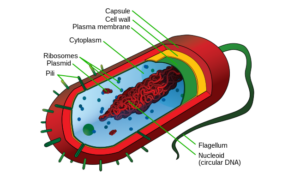1. Cell structure and Function
1.1.Prokaryotic cell Structure
Cell structure and Function
Dr V Malathi and Sushumna Rao
- A prokaryote is a simple, mostly single-celled (unicellular) organism
- Prokaryotes lacks a nucleus, or any other membrane-bound organelle.
- Prokaryotic DNA is found in a central part of the cell: called the nucleoid
- All prokaryotes have chromosomal DNA localized in a nucleoid, ribosomes, a cell membrane, and a cell wall
- In addition most prokaryotes have cell wall
- The cell wall protects the prokaryotic cell , helps to maintain its shape, and prevents dehydration.
- Apart from cell wall the many prokaryotic cell also have a Capsule.
- The capsule enables the cell to attach to surfaces in its environment.
- Some prokaryotes have flagella, pili, or fimbriae.
- Flagella are used for locomotion.
- Pili are used to exchange genetic material during a type of reproduction called conjugation.
- Fimbriae are used by bacteria to attach to a host cell.

“Prokaryotic Cell” by LadyofHats is in Public Domain
Test Youself-1

